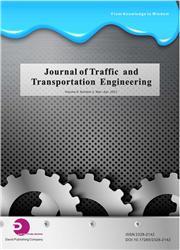Resilient Behavior of Modified Asphalt Concrete Mixture
引用次数: 0
Abstract
Asphalt concrete pavement is designed to exhibit elastic behavior under loading at cold weather condition and a combination of elastic, plastic and viscous behavior at hot weather condition. Distress of the pavement usually starts with initiation of micro cracking due to load repetition, while such cracks can heal by themselves in slow process under repeated loading, external or internal heating, and provision of rest period at ambient temperature. The aim of this work was to assess the resilient behavior of modified asphalt concrete using three types of polymer additives such as starien- butadien- stairen (SBS), low density poluetheline (LDPE), and scrap tire rubber. Beam specimens of 381.0 mm length, 76.2 mm width, and 76.2mm thickness have been prepared with optimum asphalt content requirement and with extra 0.5% asphalt above and below the optimum. Beam specimens were tested under repeated flexure stress. The applied stress level was 138 kPa at 25°C. The loading cycle consist of 0.1 second loading application followed by 0.9 seconds of rest period. The test was conducted for 660 load repetitions using the Pneumatic repeated load system (RPLS) to allow for the initiation of micro cracks. After the specified loading cycles, the test was stopped and the Specimens have been withdrawn from the testing chamber of PRLS and stored in the oven for two hours at 60°C environment to allow for possible micro crack healing. The specimens were then subjected to another loading cycle. Permanent, total and resilient deformations were captured through LVDT. The resilient modulus was calculated and compared among various conditions. Test results showed that the implemented polymer additives and the process of micro crack healing have positive influence on resilient modulus and deformation variables of asphalt concrete.改性沥青混凝土混合料的回弹性能
沥青混凝土路面设计为在寒冷天气条件下表现出弹性行为,在炎热天气条件下呈现出弹性、塑性和粘性行为的组合。路面的损伤通常始于荷载重复引起的微裂缝,而在重复荷载、外部或内部加热以及环境温度下提供休息期的情况下,这些裂缝可以在缓慢的过程中自行愈合。本工作的目的是评估使用三种类型的聚合物添加剂(如淀粉-丁二烯-苯乙烯(SBS)、低密度聚乙烯(LDPE)和废轮胎橡胶)的改性沥青混凝土的回弹性能。根据最佳沥青含量要求,制备了381.0 mm长、76.2 mm宽和76.2 mm厚的梁试样,并在最佳沥青含量之上和之下添加了0.5%的额外沥青。梁试件在反复弯曲应力作用下进行了试验。25°C时施加的应力水平为138 kPa。加载周期包括0.1秒的加载,然后是0.9秒的休息时间。使用气动重复载荷系统(RPLS)进行660次载荷重复试验,以允许微裂纹的萌生。在规定的加载循环后,停止试验,将试样从PRLS的试验室中取出,并在60°C的环境下在烘箱中储存两小时,以允许可能的微裂纹愈合。然后对试样进行另一个加载循环。通过LVDT捕捉永久性、整体性和弹性变形。计算了弹性模量,并在各种条件下进行了比较。试验结果表明,所加入的聚合物添加剂和微裂纹愈合过程对沥青混凝土的弹性模量和变形变量有积极影响。
本文章由计算机程序翻译,如有差异,请以英文原文为准。
求助全文
约1分钟内获得全文
求助全文

 求助内容:
求助内容: 应助结果提醒方式:
应助结果提醒方式:


